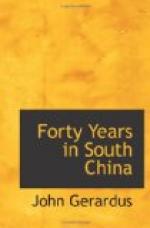We have had no name to add to the foreign missionary martyr list, from the region of Amoy.
Chinese martyrs there may have been. Men who have endured the lifelong laceration of taunt and sneer and suffered the loss of well nigh all things, there have been not a few. Though the fires of persecution have burned with fiercer intensity in other parts of China, yet we have not escaped having our garments singed in some of their folds.
Perhaps the most widespread anti-missionary uprising in China occurred during the years 1870 and 1871.
It was during the summer of 1870 that Dr. Talmage was compelled to go to Chefoo, North China, for much-needed rest and change.
On August 8th he wrote to Dr. J. M. Ferris:
“The next day after my arrival at Chefoo the news was received of the terrible massacre at Tientsin on June 21st. (Tientsin is the port of Peking, and has a population of upwards of one million.) Nine Sisters of Charity, one foreign priest, the French consul and other French officials and subjects, and three Russians—in all, twenty-one Europeans—were massacred. Many of them were horribly mutilated. Especially is this true of all the Sisters. Their private residences and public establishments, as well as all the Protestant chapels within the city, were destroyed.”
Not long after, the American Presbyterian Mission at Tung chow, Shantung Province, North China, was broken up, for fear of an intended massacre. The missionaries were helped to Chefoo by two vessels sent by the British Admiral, Sir Henry Kellet.
At Canton, vile stories about foreigners distributing poisonous pills were gotten up, and such was the seriousness of the crisis that two German missionaries had to flee for their lives, one having his mission premises utterly destroyed. A people whose credulity is most amazingly developed by feeding on fairy tales and demon adventures from their childhood, are prepared to believe anything about the “ocean barbarians” whose name is never spoken without mingled fear and hatred and suspicion.
The ferment, started at Canton, spread along the coast. The people of Amoy were inoculated with the virus.
On the 22d of September, 1871, Dr. Talmage addressed a letter to General Le Gendre, U. S. Consul at Amoy, informing him of the state of affairs in and about Amoy. The missionary knowing the language and having constant dealings with the people would be more likely to know the extent and gravity of any conspiracy against foreigners than the Consul. A part of the letter reads:




